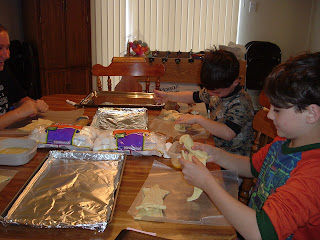To start the day off, we made Resurrection Rolls together. It is a fun way to go over the details of Jesus' death and resurrection.
Here are the instructions and below are several pictures of the kids working on the rolls and what they looked like at the end. My kids ask each year for us to do these rolls, not only because it is fun, but because they taste really good!
I hope you have a blessed Resurrection Sunday! He is Risen, He is Risen Indeed!
************************************************************
Resurrection Rolls
Here's a new twist on the Resurrection Cookie idea for Easter, both are recipes you can do with your kids/grand kids in order for them to understand the death and resurrection of Jesus Christ. This fun recipe uses Crescent rolls and a disappearing marshmallow!
Preheat Oven to 350 degrees
Ingredients:
Crescent rolls
Melted butter
Large marshmallows
Cinnamon
Sugar
Give each child a triangle of crescent rolls. The crescent roll represents the cloth that Jesus was wrapped in.
Read Matthew 27:57-61
1. Give each child a marshmallow. This represents Jesus.
2. Have him/her dip the marshmallow in melted butter. This represents the oils of embalming.
3. Now dip the buttered marshmallow in the cinnamon and sugar which represents the spices used to anoint the body.
4. Then wrap up the coated marshmallow tightly in the crescent roll (not like a typical crescent roll up, but bring the sides up and seal the marshmallow inside.) This represents the wrapping of Jesus' body after death.
5. Place in a 350 degree oven for 10-12 minutes. (The oven represents the tomb - pretend like it was three days!)
6. Let the rolls cool slightly. The children can open their rolls (cloth) and discover that Jesus is no longer there, HE IS RISEN!!!! (The marshmallow melts and the crescent roll is puffed up, but empty.)
Now read Matthew 28:5-8
Explain: At the tomb, Mary Magdalene and the other Mary saw an angel, who told them not to be afraid. No one had taken Jesus' body, but He Had risen from the dead! The angel told the women to go and tell the disciples what they had seen, that Jesus had risen from the dead. They were so excited, they ran all the way home to tell the disciples the good news! He is risen from the dead! Alleluia!
After that Jesus appeared in person to Peter, then to the 12 disciples and after that, to more than 500 people. Jesus' appearance to eyewitnesses, those who saw Him with their own eyes, would give support and prove that Jesus rose from the dead (1 Corinthians 15:3-6).
By rising from the dead, Jesus proved once and for all that He was the Messiah, the Savior of the World, the Chosen One, and the Lamb of God. By dying on the cross and rising from the dead, Jesus did what no other had ever done before. As both God and man, He overcame sin, death, and hell. And now because of what Jesus has done, these things no longer have any power over those who believe in Jesus and allow His Spirit to lead and direct them. Rather than being slaves to sin and death, Christians ( those who love and believe in Jesus) are free to obey God and do good ( Romans 6:17-18). The Bible says in John 8:36, "If therefore the Son shall make you free, you shall be free indeed."
However, we will only obey God if we listen to the Holy Spirit our helper. He enables believers in Jesus to do the right thing. It is important that we read the Bible (God's Word) because one of the ways the Holy Spirit helps us obey God is by reminding us of what He says to us in His Word. God's Spirit will never go against his Word. In fact, when we read God's Word, we are listening to the Holy Spirit. Of course, you won't always do the right thing; the Bible says this ) 1 John 1:5-10). But that is why we need to continue to confess our sins knowing that God forgives us, based on what Jesus did on the cross. This is also a reason we need to spend time with other believers in Christ so they can encourage us in our faith.
May you have a blessed and meaningful Easter!
- Author Unknown -
**********************************************************************




